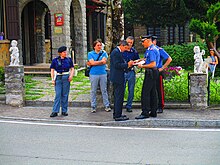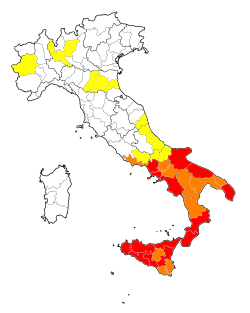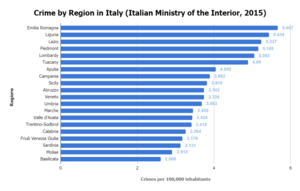Crime in Italy

Italian crime rates, though low compared to other developed countries, are present in various forms throughout the nation. Violent crimes, which include instances of murder, sexual violence, and assault, are quite rare in Italy evidenced by its homicide rate of 0.51 in 2021, the lowest in Europe aside from Luxembourg and Slovenia.[1] However, Italy is notorious for its organized crime groups,[2] which are present worldwide and collectively referred to as the Mafia. This has made financial crimes such as corruption, theft, and trafficking more widespread in the country.[3]
Description[edit]
Overview[edit]
Within Europe, Italy is placed at 8th in terms of law enforcement per 100 thousand people, surpassing the continental average of 335 units.[4] Italy is known for being a country with a higher number of regional differences than some of its fellow nations; for example, the southern region has much higher activity of organized crime, whereas the northern regions of Italy have had relatively lower levels of mafia activity.[5] Plenty of social factors have also affected crime rates throughout different regions of Italy in recent years, one specifically being immigration.[5] As of 2023, the north of Italy receives much more immigration than the south; northern Italy comprises 58,7% of foreigners living in Italy, while central Italy houses 25,0%, southern Italy 11,9% and the islands 4,7%, leading to a northbound shift in criminality.[6] Compounding this, the chart on the right demonstrates that in the year 2015, the northern region of Emilia Romagna, which has a higher number of immigrants, had the highest crime rate in Italy per 100,000 people, with a number of 5,667. On the contrary, the southern region of Basilicata had the lowest crime rate per 100,000 people with a number of 2,608.[7]
Law Enforcement and Justice System[edit]

Italy is not just defined by its criminal entities, and it actively addresses such challenges through a network of Italian law enforcement systems.[8] The three main organizations are the Carabinieri,[9] the Polizia di Stato (State Police),[10] and the Guardia di Finanza (Financial Guard).[11] The policing system is essentially split between these three organizations, and it's their responsibility to maintain peace and order within the nation. Something that's recently emerged into Italy is the idea of rehabilitating and reevaluating the prison system. Things changed with the introduction of Law n. 395, which established prison officers as an independent police form, along with enforcing changes in the organization of the prison staff.[12] The law required them to engage in a program that had two duties, one being the achievement of order-related goals and the second being their active engagement in rehabilitation programs for the prisoners.[12] The goal of this was to make the prison guards not just enforcers but also giving them the responsibility of being involved in and supporting prisoners' rehabilitation.[12]
Crime by type[edit]
Homicide and Assault[edit]
In the 1990's homicide rates per 100,000 people ranged from 2.8 to 1.4. In the 2000s it decreased with a range from 1.31 to 0.98 per 100,000 people. From 2010-2020 it decreased even more so with a data range of 0.93 to 0.67 homicides per 100,000 people.[13] Over the past decade, Italy has witnessed a notable decline in homicide rates, marking a 20% decrease over time with a current rate of 0.6 murders per 100,000 people.[14] Between August of 2018 and July of 2019, only 307 murders were recorded. Furthermore, in between August 2020 and July 2021, there were 276 homicides, showcasing a considerable reduction from previous years and decades.[15]
Organized Crime[edit]

Organized Crime in Italy has pervasive influence on Italian society, with a reported 22% of citizens and 14.6% of Italy's Gross Domestic Product directly affected its impact.[16] Some public leaders, such as former Prime Minister Silvio Berlusconi, have faced investigation on their alleged involvement in organized criminal activity.[17]
There are four major organized crime groups that have reigned over Italy throughout the last century; Cosa Nostra, Camorra, Apulian Organized Crime and 'Ndrangheta, and all four of them run on different methods. The 'Ndrangheta has become the richest of all four, as it runs the drug trade in all Europe, in Australia and in some areas of Canada and USA.[18] Camorra has been and continues to be the most violent mafia group, committing more murders than the other three combined. These Italian mafia groups are infamous not just in Italy but throughout the world, and they are a hot commodity for entrepreneurs, and other people looking for work and business endeavors.[18]
There has been a significant decrease in mafia-related murders over the years. In 2020, there were only 28 reported murders linked to the Mafia, which is a notable decline compared to an average of 527 murders annually between 1988 and 1992.[19] Although, the issue of measuring the presence and mapping the types of Mafias in Italy presents a significant challenge, despite their relevance in Italian society. There are only two organizations that have attempted to agge their impact; the Organized Crime Index (OCI) and the M.A.C.R.O project.[20] The nature of the OCI index makes it unsuitable for accurately measuring Mafia presence across Italy. Whereas the M.A.C.R.O project remains non-operational according to Italian law enforcement agencies. In order to address these shortcomings, recent initiatives by Transcrime have sought to develop a more reliable and accurate measurement of mafia presence - The Mafia Index. The Mafia Index's mapping reveals significant Costa Nostra presence in Western Sicily, 'Ndrangheta in southern Calabria, the Camorra Barese in Bari, the Sacra Corona Unita in southern Apulia, the Società Foggiana and the Mafia del Gargano in the province of Foggia and the Camorra in Naples and Caserta.[20]
Sexual Violence and Human Trafficking[edit]
Italy exhibits a comparatively lower per capita rate of rape in comparison to several advanced Western countries within the European Union.[21] Based on police authority data, there is a notable disparity in the rate of sexual assaults per 100,000 inhabitants between the Northern and Southern regions of Italy. In 2009, Lombardy and Emilia Romagna reported the highest rate of sexual offenses per 100,000 inhabitants (9.7).[22] Trailed closely by Trentino Alto Adige and Tuscany (9.5), as well as Piedmont and Liguria (8.6). Umbria documented a rate of 8.4 incidents. Major Southern regions such as Sicily (6.8). Calabria (6.5), Apulia (6.2) and Campania (6.0) were comparatively safer within the national territory. Notably, Friuli Venezia Giulia, stood as an exception among the Southern regions in terms of lower reported rates.[22]
Financial Crime and Corruption[edit]

Fraud stands as a pervasive issue within Italy's social framework, manifesting across various sectors of the economy since the nations inception in 1861. Prominent instances of financial deceit, such as the Parmalat collapse[24] in the early 21st century and the Lockheed bribery scandal[25] in the 70s, underscore the breadth of this problem.
A critical analysis of corruption and anti-corruption policies in Italy was conducted in 2020. The Study assesses Law n. 3 on 9 January 2019. known as the "Measures to fight crimes against the public administration and on the transparency of political parties and movements", or the bribe-destroyer law.[26] It delves into the legislative innovation this law represents in minimizing corruption in Italy. The analysis raises concerns about the insufficiency of solely increasing criminalization without addressing the underlying ethical deficit in public conduct, suggesting that legal measures alone might not effectively contain the phenomenon of corruption.[26]
Drug-Related Crimes[edit]
Italy serves as a significant entry point for illegal drugs into Europe, owing to its strategic geographic location and the pervasive presence of organized crime syndicates.[27] Substantial quantities of illicit substances are trafficked through the country, destined for distribution in other European nations. These drugs come from all different places, cocaine from regions like South America, particularly Colombia, heroine sourced from Southeast Asia and Afghanistan, and cannabis cultivated in north-western and southeastern Europe.[27]
A comprehensive survey on drug usage conducted in 2017 revealed that a sizeable number of Italians aged between 15 and 64 had experimented with psychoactive substances at least once in their life.[27] Despite this, Italy maintains a relatively low number of annual drug use deaths compared to other countries; in 2019 there were 374 deaths, while in 2020 there were 308, indicating an improving situation.[28] 46.10% of drug abuse deaths occurred in Northern Italy, 27.27% in Central Italy, and 26.62% in Southern Italy and the Islands.[28]
A study done on New Psychoactive Substances (NPS) seized in Italy over a two-year period, it shed light on the prevalence and diversity of illicit drugs intercepted within the country's borders. From 2013 to 2015, a total of 162 seizures of substances purchased on the internet and confiscated by law enforcement agencies were scrutinized.[29] Furthermore, 35 seizures, accounted for 22% of composed crystals of methylmethcathinone (3-MMC), while 4-methylmethcathinone (4-MEC) crystals constituted 20% of the seizures.[30] The study's key takeaways include the threat of the absence of accurate labeling or misleading information on these substances, and the necessity for stricter regulation and monitoring to safeguard public well-being.[30]
Crime by region[edit]

Southern Italy[edit]
Southern Italy exhibits lower overall crime rates in comparison to Northern Italy. However, Mafia-related corruption and extortion are widely prevalent in Campania, Sicily, Calabria, and adjacent areas. Such crimes also extend into certain northern urban centers,[31] but Naples and some provinces of Calabria, Apulia and Sardinia have a higher murder rate than northern cities.
Sicily[edit]
Crime in Sicily has consistently been dominated by the Cosa Nostra mafia group throughout history. As such, Sicilian criminality has been highly glamorized in the American film industry. However, it is highly unlikely that civilians or tourists will run into any trouble with the Mafia.[30] Violent crime is very low; at 0.37, the homicide rate in Sicily is among the lowest in both Italy and the world.[32] However, petty crimes such as fraud and pickpocketing are not as uncommon in Sicily. Furthermore, extortion is endemic, as an estimated 80% of Sicilian businesses pay a pizzo to the Mafia.[33] Resultantly, more than 160 million euros are extorted yearly from businesses in Palermo, and investigators estimate that Sicily as a whole pays 10 times that figure.[34]
Central and Northern Italy[edit]
In comparison with southern Italy, the central and northern regions of the country are generally perceived as less prone to crime by foreigners. However, in recent years, the north has tended to exhibit slightly higher levels of crime than the south, evidenced by the northern cities of Milan, Florence, Turin, Genoa, and Rimini scoring the highest crime rates in Italy.[35] On the other hand, regions such as Marche, Tuscany, Umbria, and Friuli Venezia Giulia show relatively lower indicators of criminality.[35] Despite this, the northern regions of Italy have consistently demonstrated lower levels of extortion and corruption than their southern counterparts.
Rome[edit]
According to the European Union’s statistics-gathering wing, there were 0.7 homicides per 100,000 people in Rome as of 2015.[36] This puts the homicide rate in the capital at a slightly higher rate than the national average of 0.5, but this is still by all accounts a very low homicide rate, especially for a large city, and amongst the lowest in European capital cities. As with the rest of Italy, pickpocketing, petty fraud, and grand theft auto are much more common than violent crimes.
References[edit]
- ^ “Vittime di Omicidio | Anno 2021.” 24 November 2022. Istituto Nazionale di Statistica. <https://www.istat.it/it/files//2022/11/REPORT-VITTIME-DI-OMICIDIO_2021.pdf> (31 December 2023).
- ^ “Organized Crime.” 2023. Wikipedia. https://en.wikipedia.org/w/index.php?title=Organized_crime&oldid=1186067314 (6 December 2023).
- ^ “Organized Crime in Italy.” 2023. Wikipedia. https://en.wikipedia.org/w/index.php?title=Organized_crime_in_Italy&oldid=1184766195 (6 December 2023)
- ^ Pasztor, Maria (2019), "La Repubblica Popolare Polacca (PRL) e la Repubblica Italiana negli anni 1945-1989: relazioni all'ombra della «Cortina di Ferro» PRL – Republika Włoska 1945-1989: relacje w cieniu „żelaznej kurtyny"", Italia e Polonia (1919-2019). Un meraviglioso viaggio insieme lungo cento anni / Włochy i Polska (1919-2019). Sto lat wspólnej fascynującej podróży, Warsaw University Press, retrieved 2023-12-06
- ^ a b Solivetti, Luigi M. (September 2016). "Crime Patterns between Tradition and Change: A Territorial Analysis of the Italian Provinces". Social Indicators Research. 128 (2): 531–558. doi:10.1007/s11205-015-1043-1. hdl:11573/862819. ISSN 0303-8300. S2CID 255004999.
- ^ “Popolazione residente e dinamica demografica.” 18 December 2023. Istituto Nazionale di Statistica. <https://www.istat.it/it/files/2023/12/CENSIMENTOEDINAMICADEMOGRAFICA2022.pdf> (31 December 2023).
- ^ Tramullas, Jesús; Ojeda, Rubén (9 September 2018). "Líneas para el desarrollo de proyectos con Wikipedia y Wikimedia Commons en museos y bibliotecas". dx.doi.org. doi:10.31235/osf.io/9j6vx. S2CID 194925182. Retrieved 7 December 2023.
- ^ “Law Enforcement in Italy.” 2023. Wikipedia. https://en.wikipedia.org/w/index.php?title=Law_enforcement_in_Italy&oldid=1174517595 (6 December 2023).
- ^ “Carabinieri.” 2023. Wikipedia. https://en.wikipedia.org/w/index.php?title=Carabinieri&oldid=1187474169 (6 December 2023).
- ^ “Polizia Di Stato.” 2023. Wikipedia. https://en.wikipedia.org/w/index.php?title=Polizia_di_Stato&oldid=1183832854 (6 December 2023).
- ^ “Guardia Di Finanza.” 2023. Wikipedia. https://en.wikipedia.org/w/index.php?title=Guardia_di_Finanza&oldid=1187682149 (6 December 2023).
- ^ a b c Santorso, Simone (16 March 2021). "Rehabilitation and dynamic security in the Italian prison: challenges in transforming prison officers' roles". The British Journal of Criminology. 61 (6): 1557–1574. doi:10.1093/bjc/azab015. ISSN 0007-0955.
- ^ “List of Countries by Intentional Homicide Rate by Decade.” 2023. Wikipedia. https://en.wikipedia.org/w/index.php?title=List_of_countries_by_intentional_homicide_rate_by_decade&oldid=1171384291 (5 December 2023).
- ^ "I numeri della dispersione scolastica in Italia e in Europa". QT Quaderni di Tecnostruttura (47): 91–111. December 2012. doi:10.3280/qt2012-047008. ISSN 1828-5163.
- ^ "Italy: number of homicides 2011-2021". Statista. Retrieved 7 December 2023.
- ^ Kington, Tom. 2009. “Mafia’s Influence Hovers over 13m Italians, Says Report.” The Guardian. https://www.theguardian.com/world/2009/oct/01/mafia-influence-hovers-over-italians (15 December 2023).
- ^ “Mafioso ‘Claimed Berlusconi Link.’” 2009. http://news.bbc.co.uk/2/hi/8395280.stm (15 December 2023).
- ^ a b Catino, Maurizio. 2020. “Italian Organized Crime since 1950.” Crime and Justice 49: 69–140.
- ^ “Omicidi, Mai Così Pochi in Italia. Crollano Le Vittime Della Mafia- Corriere.It.” https://www.corriere.it/cronache/21_febbraio_09/omicidi-mai-cosi-pochi-italia-crollano-vittime-mafia-b408cda6-6ab8-11eb-8b10-8eef7b7ae281.shtml (15 December 2023).
- ^ a b “Measuring the Presence of the Mafias in Italy | SpringerLink.” https://link.springer.com/chapter/10.1007/978-3-319-01839-3_27 (15 December 2023).
- ^ Copes, Heith; Miller, J., eds. (2 March 2015). Qualitative research on elite frauds, ordinary frauds, and "organized crime". Routledge. pp. 231–251. doi:10.4324/9780203074701. ISBN 978-0-203-07470-1.
{{cite book}}:|work=ignored (help) - ^ a b Husemann, Tim (1 June 2023). "Altersgrenzen beim Berufseinstieg: Wer muss was wann können? — Anmerkung zu EuGH, Urt. v. 17.11.2022 – C- 304/21 – Ministero dell'Interno". Zeitschrift für das Privatrecht der Europäischen Union. 20 (3): 124–127. doi:10.9785/gpr-2023-200309. ISSN 2364-7213. S2CID 259112911.
- ^ "BBC NEWS - Business - Italian dairy boss gets 10 years". 18 December 2008. Retrieved 16 October 2016.
- ^ “Parmalat.” 2023. Wikipedia. https://en.wikipedia.org/w/index.php?title=Parmalat&oldid=1183968106 (15 December 2023).
- ^ “Lockheed Bribery Scandals.” 2023. Wikipedia. https://en.wikipedia.org/w/index.php?title=Lockheed_bribery_scandals&oldid=1186803226 (15 December 2023).
- ^ a b Maggio, Paola (28 March 2020). "A critical analysis of corruption and anti-corruption policies in Italy". Journal of Financial Crime. 28 (2): 513–530. doi:10.1108/jfc-12-2019-0168. ISSN 1359-0790. S2CID 214792217.
- ^ a b c "EMCDDA home page | www.emcdda.europa.eu". www.emcdda.europa.eu. Retrieved 15 December 2023.
- ^ a b “Annual report 2021.” 2021. Direzione centrale per i servizi antidroga. <https://antidroga.interno.gov.it/wp-content/uploads/2021/07/Annual-report-2021.pdf> (16 January 2024).
- ^ Odoardi, Sara; Romolo, Francesco Saverio; Strano-Rossi, Sabina (August 2016). "A snapshot on NPS in Italy: Distribution of drugs in seized materials analysed in an Italian forensic laboratory in the period 2013–2015". Forensic Science International. 265: 116–120. doi:10.1016/j.forsciint.2016.01.037. hdl:10446/145558. ISSN 0379-0738. PMID 26874736.
- ^ a b c "Crime in Sicily | Italy Heaven". www.italyheaven.co.uk. Retrieved 15 December 2023.
- ^ https://it.wikipedia.org/wiki/Criminalit%C3%A0_in_Italia [bare URL]
- ^ Eurostat, 2019
- ^ "Italy's biggest business: the Mafia". The Daily Telegraph. 24 October 2007. Archived from the original on 26 October 2007.
- ^ "Mafia-free supermarket defies mob extortion". The Daily Telegraph. 8 March 2008. Archived from the original on 9 March 2008.
- ^ a b "Le città più pericolose d'Italia, la classifica aggiornata". Money.it (in Italian). 10 October 2023. Retrieved 15 December 2023.
- ^ "Crime in Rome". revealedrome.com. 3 November 2010. Retrieved 27 December 2023.
External links[edit]
- Italy Black Markets Havocscope Black Market
